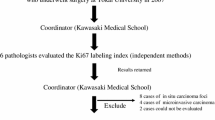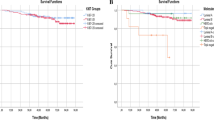Abstract
Breast cancer is the most common cancer in women, and the search for effective markers to design therapeutic strategies and patient management algorithms is still a work in progress. Ki67, a proliferative marker, has gained attention as a prognostic and predictive factor in early breast cancer and/or to decide response to chemotherapy. Individual studies and meta-analyses have provided evidence of its usefulness in this regard. Immunohistochemical staining Ki67 has emerged as an easy and cheap tool to assess proliferation in laboratory setting. However, debate continues over its meaningful clinical use, given the lack of standardization of staining techniques and firm recommendations about pre-analytical tissue handling, interpretation of the stain, and methods to estimate Ki67, resulting in high interlaboratory and interobserver variability. Importantly, no consensus has been reached on the cut-off values for risk stratification. The Breast Cancer Working Group proposed guidelines for immunohistochemical evaluation of Ki67 in 2011. However, the follow-up study showed poor reproducibility even among experts, and the use of Ki67 in daily practice is still in question.
Similar content being viewed by others
References
Papers of particular interest, published recently, have been highlighted as: •• Of major importance
Cummings MC et al. Molecular classification of breast cancer: is it time to pack up our microscopes? Pathology. 2011;43:1–8.
Dowsett M et al. Assessment of Ki67 in breast cancer: recommendations from the International Ki67 in Breast Cancer working group. J Natl Cancer Inst. 2011;103:1656–64. Describes in detail the recommendations proposed by the Breast Cancer Working.
Yerushalmi R et al. Ki67 in breast cancer: prognostic and predictive potential. Lancet Oncol. 2010;11:174–83.
Gudlaugsson E et al. Comparison of the effect of different techniques for measurement of Ki67 proliferation on reproducibility and prognosis prediction accuracy in breast cancer. Histopathology. 2012;61:1134–44.
Inwald EC et al. Ki-67 is a prognostic parameter in breast cancer patients: results of a large population-based cohort of a cancer registry. Breast Cancer Res Treat. 2013;139:539–52.
Feeley LP et al. Distinguishing luminal breast cancer subtypes by Ki67, progesterone receptor or TP53 status provides prognostic information. Mod Pathol. 2014;27:554–61.
Polley MY et al. An international Ki67 reproducibility study. J Natl Cancer Inst. 2013;105:1897–906. Highlights the results of the reproducibility study of Ki67 based on the proposed recommendations.
Goldhirsch A et al. Personalizing the treatment of women with early breast cancer: highlights of the St Gallen International Expert Consensus on the Primary Therapy of Early Breast Cancer 2013. Ann Oncol. 2013;24:2206–23.
Wesolowski R, Ramaswamy B. Gene expression profiling: changing face of breast cancer classification and management. Gene Expr. 2011;15:105–15.
Colozza M, Sidoni A, Piccart-Gebhart M. Value of Ki67 in breast cancer: the debate is still open. Lancet Oncol. 2010;11:414–5.
Lawry J et al. The value of assessing cell proliferation in breast cancer. J Microsc. 1990;159(Pt 3):265–75.
Fitzgibbons PL et al. Prognostic factors in breast cancer. College of American Pathologists Consensus Statement 1999. Arch Pathol Lab Med. 2000;124:966–78.
de Azambuja E et al. Ki-67 as prognostic marker in early breast cancer: a meta-analysis of published studies involving 12,155 patients. Br J Cancer. 2007;96:1504–13.
Bouzubar N et al. Ki67 immunostaining in primary breast cancer: pathological and clinical associations. Br J Cancer. 1989;59:943–7.
Stuart-Harris R et al. Proliferation markers and survival in early breast cancer: a systematic review and meta-analysis of 85 studies in 32,825 patients. Brea. 2008;17:323–34.
Reyal F et al. Long-term prognostic performance of Ki67 rate in early stage, pT1-pT2, pN0, invasive breast carcinoma. PLoS ONE. 2013;8:e55901.
Nishimura R et al. Ki-67 as a prognostic marker according to breast cancer subtype and a predictor of recurrence time in primary breast cancer. Exp Ther Med. 2010;1:747–54.
Ellis MJ, et al. Outcome prediction for estrogen receptor-positive breast cancer based on postneoadjuvant endocrine therapy tumor characteristics. J Natl Cancer Inst. 2;100:1380–8.
Cuzick J et al. Prognostic value of a combined estrogen receptor, progesterone receptor, Ki-67, and human epidermal growth factor receptor 2 immunohistochemical score and comparison with the Genomic Health recurrence score in early breast cancer. J Clin On. 2011;29:4273–8.
Dowsett M et al. Comparison of PAM50 risk of recurrence score with oncotype DX and IHC4 for predicting risk of distant recurrence after endocrine therapy. J Clin O. 2013;31:2783–90.
Penault-Llorca F et al. Ki67 expression and docetaxel efficacy in patients with estrogen receptor-positive breast cancer. J Clin Oncol. 2009;27:2809–15.
Sueta A et al. Clinical significance of pretherapeutic Ki67 as a predictive parameter for response to neoadjuvant chemotherapy in breast cancer: is it equally useful across tumor subtypes? Surgery. 2014;155:927–35.
Dowsett M et al. Endocrine therapy, new biologicals, and new study designs for presurgical studies in breast cancer. J Natl Cancer Inst Monogr. 2011;2011:120–3.
Pinhel IF et al. Extreme loss of immunoreactive p-Akt and p-Erk1/2 during routine fixation of primary breast cancer. Breast Cancer Res. 2010;12:R76.
Bai Y et al. Quantitative assessment shows loss of antigenic epitopes as a function of pre-analytic variables. Lab Invest. 2011;91:1253–61.
Laurinavicius A et al. A methodology to ensure and improve accuracy of Ki67 labelling index estimation by automated digital image analysis in breast cancer tissue. Breast Cancer Res. 2014;16:R35.
Gokhale S et al. Assessment of two automated imaging systems in evaluating estrogen receptor status in breast carcinoma. Appl Immunohistochem Mol Morphol. 2007;15:451–5.
Romero Q et al. A novel model for Ki67 assessment in breast cancer. Diagn Pathol. 2014;9:118.
Caldarella A, Crocetti E, Paci E. Ki67 in breast cancer: a useful prognostic marker? Ann Oncol. 2014;25:542.
Denkert C et al. Ki67 levels as predictive and prognostic parameters in pretherapeutic breast cancer core biopsies: a translational investigation in the neoadjuvant Gepartrio trial. Ann Oncol. 2013;24:2786–93.
McCormick D et al. The relevance of antibody concentration to the immunohistological quantification of cell proliferation-associated antigens. Histopathology. 1993;22:543–7.
Cserni G et al. Distribution pattern of the Ki67 labelling index in breast cancer and its implications for choosing cut-off values. Breast. 2014;23:259–63.
Wiesner FG et al. Ki-67 as a prognostic molecular marker in routine clinical use in breast cancer patients. Breast. 2009;18:135–41.
Li FY et al. Prognostic value of Ki-67 in breast cancer patients with positive axillary lymph nodes: a retrospective cohort study. PLoS ONE. 2014;9:e87264.
Engels CC et al. The prognostic value of apoptotic and proliferative markers in breast cancer. Breast Cancer Res Treat. 2013;142:323–39.
Compliance with Ethics Guidelines
ᅟ
Conflict of Interest
Constance Albarracin and Sagar Dhamne declare that they have no conflicts of interest.
Human and Animal Rights and Informed Consent
This article does not contain any studies with human or animal subjects performed by any of the authors.
Author information
Authors and Affiliations
Corresponding author
Rights and permissions
About this article
Cite this article
Albarracin, C., Dhamne, S. Ki67 as a Biomarker of Prognosis and Prediction: Is it Ready for Use in Routine Pathology Practice?. Curr Breast Cancer Rep 6, 260–266 (2014). https://doi.org/10.1007/s12609-014-0163-y
Published:
Issue Date:
DOI: https://doi.org/10.1007/s12609-014-0163-y




